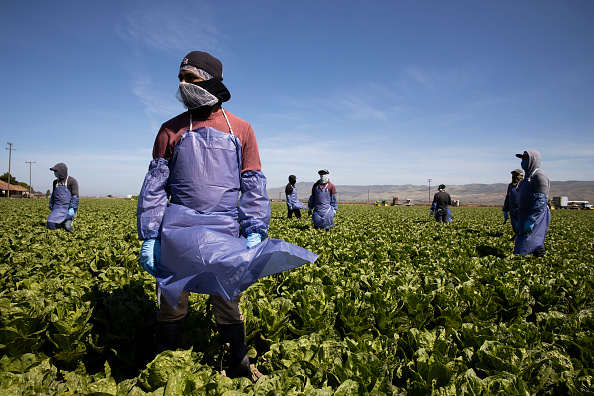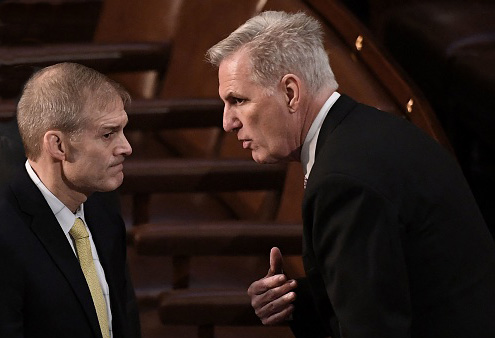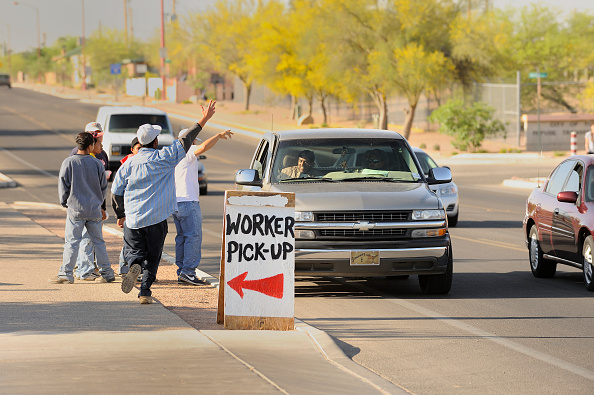Views expressed by any party interviewed by Ideaspace are those of the interviewee and are not necessarily shared by Ideaspace.

Last month, Ideaspace published a wide-ranging report detailing why the Affordable and Secure Food Act failed in the U.S. Senate. Immigration and farm advocates from both sides of the political aisle were sorely disappointed when the bill floundered last December, as the legislation would have addressed the plight of undocumented farmworkers and the severe farm labor shortages threatening the U.S. agriculture industry, as well as runaway food inflation impacting American families.
Our report was largely focused on the why and the how of the bill’s failure, which included competing interests between Democratic and Republican lawmakers, and between the American Farm Bureau Federation and state farm bureaus. As such, our reporting centered on lawmakers, state farm bureau representatives, and researchers with varying degrees of proximity to the Affordable and Secure Food Act. In this follow-up to that article, we offer a farmer’s perspective.
 Jim Bittner has been farming tree fruit — apples, peaches, and cherries — in Western New York since 1990. Until 2015, Bittner was able to operate with a domestic workforce. But a dwindling domestic farm labor pool has forced Bittner to increasingly rely on the H-2A visa program for the September/October harvest season. Today, 80 percent of his harvest season workforce are migrant laborers who come through the H-2A program, which Bittner says causes excessive labor costs and administrative burden. As a result, he has reduced his crop output by 15 percent.
Jim Bittner has been farming tree fruit — apples, peaches, and cherries — in Western New York since 1990. Until 2015, Bittner was able to operate with a domestic workforce. But a dwindling domestic farm labor pool has forced Bittner to increasingly rely on the H-2A visa program for the September/October harvest season. Today, 80 percent of his harvest season workforce are migrant laborers who come through the H-2A program, which Bittner says causes excessive labor costs and administrative burden. As a result, he has reduced his crop output by 15 percent.
Count Bittner among the farmers who were disappointed that the Affordable and Secure Food Act did not become law. In addition to its promise to expand the domestic farm labor pool, Bittner supported the bill because it would have reformed the H-2A visa program. Chief among the reforms in the Affordable and Secure Food Act is a 3-percent year-over-year cap on the Adverse Effect Wage Rate, or AEWR, which refers to the minimum wage a farm employer must pay to a foreign worker operating under the H-2A visa program. The idea is to maintain a high enough minimum wage for foreign workers so as to not have an “adverse effect” on the wage
rates of native-born workers. The cap would have saved farmers like Bittner from AEWR spikes ranging between 5 and 15 percent, and would have provided predictability when planning out crops years in advance.
In an effort to further understand the challenges of American farmers relying on a foreign workforce, and how the Affordable and Secure Food Act could bring relief, Ideaspace spoke with Jim Bittner.
Jordan Heller: When did you first start relying on immigrant farm labor?
Jim Bittner: When we first got in. My first year in the apple business was 1990. And at that point, we were able to rely on mainly Hispanic workers. They were in Florida. They would work there in the winter and come up for us in the fall, in the summer and fall. And that was our original labor pool when I first started in the ’90s.
JH: What was their immigration status?
JB: All over the board. Some of them had legal status, some of them did not. We did have a big group that came through, got their status adjusted with the Immigration Reform and Control Act of 1986. So they got legal work authorization. So we relied on that group of people to be our main labor force for a number of years. In fact, there’s still some of them here today.
JH: And I assume that labor pool has aged out.
JB: Yes. We did everything we could to stay with the domestic seasonal workers. And it got to the point where we just didn’t have enough of them starting eight years ago. In 2015, that’s when I had to turn to the H-2A program to start getting some of our seasonal harvest workers. When we started eight years ago, probably 25 percent of our seasonal labor was H-2A. Today, it’s 80 percent.

As the domestic seasonal help either aged out or moved on to other professions, other job opportunities, we could not find domestic replacements for those workers. So that’s why we ended up going to H-2A. I hate the H-2A program. I always said if I had to go there, I’d quit farming first, but here I am.
JH: If 80 percent of your seasonal workforce are H-2A, who comprises the remaining 20
percent?
JB: They’re domestic seasonal workers. Some of them live here year round. Some of them go back to Mexico in the wintertime. They either have a green card or they’re American citizens.
JH: So it appears the H-2A program is meeting your labor needs.
JB: Well, in a perfect world, we’d be 100 percent domestic. We wouldn’t have to rely on the H-2A program. So we fulfill any shortage we have with H-2A. I mean, H-2A is readily available.
JH: What is your complaint about the H-2A program?
JB: It’s the red tape and the cost of it. And the rules keep changing. I mean, the biggest one, the new rules that just came out for this year. I have another small farm near us, and we were filing a joint application, so workers could move between our two farms, and they could have full employment for the whole season because that farm had early apples. I had mainly later apples. We could move workers around and keep them working. And I’ll say it bluntly, arbitrarily, this federal Labor Department decided you can’t do that anymore. Why? I still don’t understand. They hurt the workers and the employers doing it.
JH: So when it comes to the Affordable and Secure Food Act, for you, labor shortage is not your issue. Your issue is revision of the H-2A program.
JB: Two things. I’m sure no matter what the federal government does, we’ll still have to use some H-2A. But boy, it’d be nice if we could find more domestic workers that would be seasonal, that would want to work on farms with the correct immigration status. That’s just not in the cards.
JH: So within the Affordable and Secure Food Act, you see the Certified Agricultural Worker program (which would confer legal status on undocumented workers already in the U.S. and put them on a path to permanent residence status) as a solution to your problem.
JB: Yes: to have adjusted status to people who are here and to make the H-2A program more streamlined. I mean, we would probably keep our feet in both camps, in both sources of labor. And that’s what we would probably do just to keep our risks spread out.
JH: Can you enumerate for me the problems that you have with the H-2A visa program as it stands now?
JB: Well, the AEWR. We know that we’re in a death spiral with the AEWR. As more and more farms go to H-2A, it’s becoming more clear that the wage survey, if they’re just looking at non-H-2A farms, is almost meaningless. They’re basing next year’s AEWR on that. And it’s just going to keep going through the roof every year. That’s the biggest thing. And also, now we look at the AEWR, it’s supposed to be “adverse effect.” Well, whose wages are we affecting anymore when there’s hardly any domestic seasonal help out there?
JH: And that 3-percent year-over-year cap would give you the relief you’re looking for.

JB: Yeah, it’d make planning so much easier. Right now, it’s the big surprise the first of the year. What’s the AEWR going to be for next year? And now, you have to budget for it. And a farm like ours that grows perennial crops, orchards. I mean, we’re long term. We’re not seasonal. I’m growing annual fruits. I rework my budget every year and decide which fruit I’m going to grow. I’m planting orchards today, they’ll start producing in three years. And hopefully, we’ll have 15 years after that of good production. I need more stability and confidence to make the investments.
JH: Your business plan is looking three years and more into the future. How can you make a business plan if you can’t predict what your costs are going to be?
JB: Right. And the other thing you need to understand in a fruit farm like ours, 45, 48 percent of our total cost of production is labor. So it’s a big deal. It’s not like a crop farm that’s doing everything with machines and maybe they have 10 percent of their total cost is labor. But with ours labor is by far our number one cost. It’s 45 to 48 percent depending on the year.
JH: When the Affordable and Secure Food Act was being considered in Congress last year, were you involved in educating lawmakers?
JB: Yes. I was in the trenches there in November trying to push this through. I spent time in Washington, D.C., going to offices, telling everybody we had to have this, and was very, very disappointed when it didn’t happen. We were hitting Sen. Schumer pretty hard. We were hitting Sen. Gillibrand, our two senators. And then, we went with other people from other states with their senators, the Pennsylvania senators. We knew Sen. Crapo was on board. We had some help there, but they needed more people behind them. And it just didn’t happen.
JH: Did you have any meetings with Republican lawmakers?
JB: I don’t recall. I know we did on the House side. But of course, everybody says the House already did their job. You need to hit on the Senate side.
JH: My article on the Affordable and Secure Food Act describes where the impasse was, which was the AEWR. According to my reporting, where the Republican support was lost was over the AEWR, over the idea that the law would’ve codified a flawed AEWR structure. So even though the law would’ve put a 3-percent year-over-year cap on the AEWRs, Republicans still didn’t like that the AEWR was increasing even at 3 percent year-over-year. According to David Bier of Cato, what the Republicans wanted and what the American Farm Bureau Federation wanted was a freeze on wages.

JB: My comeback to that is, as a farmer, as a user of H-2A and an employer of a lot of people, there was no way we were going to get a bill that was perfect. There had to be compromise. And we just felt that we would rather get a bill that was an improvement, but still flawed, than nothing. And that’s what we got now, is nothing. We always have people standing back looking for the perfect, in their eyes, the perfect bill. And it’s never going to happen. Everything’s going to be a compromise. And that’s what I keep saying to people is, “Yeah, probably there are parts of this that you’re not happy with.” The right to private action lawsuit was another one. We already have that in New York State. I’m not afraid of that. I should say, “Yeah, I’m afraid of it.” But we already deal with it. We’re not going to get a perfect bill. It’s just not going to happen. So you have to decide where you’re going to give and take here. And I just felt, personally, that 3 percent, okay, I can live with this. It’s better than where we are now.
JH: So in your view, would a freeze on wages be perfect?
JB: Sure. It would be better than 3 percent, but I didn’t see where that was ever going to happen.
JH: Do you think a freeze on wages would be fair to workers?
JB: To be honest with you, in this inflationary time, probably not. And 3 percent would still be tolerable and would get some of the Democrats to go for it. I didn’t see 3 percent as a big problem.
JH: The American Farm Bureau Federation stated that they did not support the Affordable and Secure Food Act because it would have codified a flawed AEWR structure and expanded the legal risk for farmers. Do you believe there were any additional factors to the American Farm Bureau’s position?
JB: American Farm Bureau, when it comes to labor, is heavily run by the Southeastern United States employers; Georgia, Mississippi, the Carolinas. And quite frankly, their AEWR is so much lower. And they would rather have it the way it is rather than change anything. And I think if you look at the American Farm Bureau membership, I mean, that area of the country just carries a lot of weight because they have huge membership. I mean, I’ve been at this since the ’80s with Farm Bureau. And more than once, I’ve had to tell somebody that the American Farm Bureau doesn’t represent New York State very well in some of the issues. I think they’re coming around. But they still have a very vocal membership that doesn’t want anything to do with fixing the H-2A system. And that’s why New York and California deviate sometimes on this stuff.
JH: The 2023 AEWR saw increases of between 5 and 10 percent in most of the U.S., and 14 percent in Alabama, Georgia, and South Carolina.
JB: So that didn’t come out until after the first of the year. And I think if you look in previous years, they didn’t get the big increases. I mean, their AEWR is still way below ours. And they were okay with that.
JH: But wouldn’t those southern states be better off with a 3-percent increase?

JB: In hindsight, most definitely. Probably if you talked to them back in November, no. They didn’t think that. I think the other thing which American Farm Bureau didn’t say, is the adjusted status provisions. There’s a strong sentiment that a group comes through, gets adjusted immigration status, and then they would disappear from agriculture, and we’d be right back where we are today.
JH: Even though the new law would have mandated that a worker remain, or have a total of 10 years in agriculture?
JB: I don’t think they bought that. They felt that what would happen is the same thing that happened in ’86, where they got all these people with adjusted status, and then they would just move on [to other industries]. And then we’d be right back in the same spot.
JH: Do you think that because of that 14-percent increase in Alabama, Georgia, and South Carolina, and 15 percent in Florida, that the politics might change when it comes to the American Farm Bureau serving that important part of their constituency?
JB: I’d like to think so. That and the new proposal in Florida of mandatory E-Verify, and how much the AEWR went up. I think there is some momentum now. I think there’d be more farmers on board now because of everything that’s happened since fall. I’d like to think that if the exact same bill came up today, we’d have a better chance than we had back in November.

JH: Can you elaborate on how mandatory E-Verify (the federal program for checking the immigration status of workers) would result in a farmer being more open to the Affordable and Secure Food Act?
JB: Well, all of a sudden, if you have employers that have to do E-Verify, these employers are going to have no choice but to jump into the H-2A program.
JH: Because they effectively lose their existing workforce, assuming that workforce can’t comply with E-Verify.
JB: Yes. And if they’re already in the H-2A program, they’re going to jump into it with a higher percentage. And when you jump into H-2A, it’s a rude awakening.
JH: Can you elaborate on the rude awakening that awaits those employers jumping into the H- 2A program?
JB: It’s the changing rules. The other thing is, if you’re in the H-2A program, you can guarantee that the Department of Labor Wage and Hour Division will audit you every two to three years. It’s somebody coming in and looking with a microscope over all your paperwork every two to three years. Now, I’ve been through it a few times already. Now, I mean, they never find anything. We’re following all the rules, but it’s just the time and effort that it takes.
JH: It’s an administrative burden, which costs time, and time costs money.
JB: The thing is, it’s not like they’re just saying they want to look at a couple things that they think maybe people aren’t following. They want everything that you’re required to do for labor. And if you’re not in the H-2A program, you don’t get this scrutiny.
JH: What’s the consequence if your paperwork is slightly off or incomplete?

JB: Well, they’ll threaten fines. And if they find that you’ve done something drastically wrong, they can disbar you from the program. Usually, the supervisor says, “Okay, that wasn’t anything major. Just don’t do that again.” And you change your system. So you make sure you’ve got better documentation. After you’ve been through an audit or two, you know what they’re looking for. But it’s just the administrative burden of producing all this stuff. I mean, for our few employees
(40 during harvest season; 18 the rest of the year), we’re going to cover the kitchen table here with paperwork for the inspector to go through, folder after folder, and three years worth of labor records they want to look at.
JH: Beyond the administrative burden and the AEWRs, what are the other costs for you when using the H-2A program?
JB: I pay a consultant to fill out the paperwork because I’m scared to death of doing it wrong. Changes every year. I have to pay an agent in Mexico to help usher the people through the consulate, make their appointments. And of course, then I have to pay for transportation back and forth from their home to the hotel in Monterey, and however long they’re going to be there. And then, transportation to get up to my farm, then back again at the end of the season to their home.
JH: And what is the monetary cost above the wage you’re paying to an H-2A worker?
JB: Our AEWR is $16.95 an hour. And we figure our true cost of that labor is about $22.50 an hour. But what that gives me is a reliable person that’s going to be here.
JH: If reform does not happen, if a bill like the Affordable and Secure Food Act does not become law, are you considering transitioning into a less labor-intensive form of farming, or considering transitioning out of agriculture altogether?

JB: Well, the offhand comment that’s made around here these days is, if things keep going the way they are, all we’ll have is corn, soybeans, and solar panels. I mean, we’ve already decided we can’t plant any more fresh, sweet cherries. We’re cutting way back on peaches because of the labor requirement. For every acre of apples that we’re cutting down because of economics, we’re planting a half an acre.
JH: For how long have you been reducing your production?
JB: We’ve been doing this for the last five years. I used to grow a lot of processing peaches, which is a high labor thing. We’ve lost that market. So those have all come out.
JH: So five years ago, you grew peaches. Today, you don’t. And what percentage of your farm from five years ago is now gone?
JB: Five years ago, we had about 380 acres of tree fruit in the ground. Today, we’re down over about 320. We just take that open ground and rent it out to a crop farmer who’s growing corn or soybeans.
JH: Are you hopeful that Congress may eventually act?
JB: Yes. Two things that have happened recently. They’ve had a lot of hearings on the Farm Bill. And it seems as though every hearing somebody brings up labor, which isn’t even part of the Farm Bill. But it shows that it’s top of mind. And also, for instance, our congresswoman, Rep. Claudia Tenney, has been reaching out, asking about labor. So something’s going on. If you would’ve asked me in January if anything was going to happen with immigration reform and labor in Congress in the next couple years, I’d say zero chance. But now maybe something might happen. So we need to keep pushing.
Jim Bittner is the owner of Bittner-Singer Orchards in Appleton, New York. He also serves as Executive Director of the New York State Horticultural Society.
Read More:






